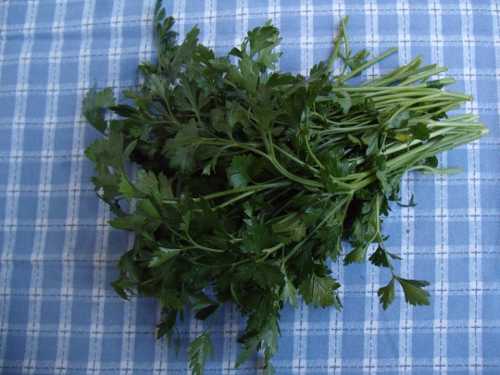
Shown here is a bundle of flat leaf parsley, also known as Italian parsley. Photo by Esther Oertel.
Parsley may be in need of an image makeover. This wonderful herb is thought of by some as nothing more than a bright little garnish or flecks of green in a side dish, but it brings far more to the table.
As the herbal adage states, “Parsley is the jewel of herbs, both in the pot and on the plate.”
It’s amazing how often I add copious amounts of fresh parsley to the meals I make.
Last evening I added a handful to pungent pasta puttanesca, I tossed it in a mushroom omelet the night before and over the last few days I’ve been happily devouring one of my favorite salad dressings, a puree of parsley with apples and ginger.
Parsley is native to the southern Mediterranean region and grows wild from Sardinia east to Lebanon, as well as in the northern African nations of Algeria and Tunisia. It’s naturalized throughout much of Europe and figures heavily in the cuisines of that continent, as well as in the Middle East.
While it’s been cultivated for more than 2,000 years, it was used medicinally prior to its popularity in cooking. The ancient Greeks viewed parsley as sacred, and used it to adorn winners of athletic contests, as well as the tombs of the dead.
Parsley’s name is derived from the Greek word for “rock celery,” with celery being one of its relatives.
It’s unclear when it became popular as an addition to food. Some historians claim the practice goes back as least as far as the time of Charlemagne in Medieval Europe, as it was grown in his gardens. Prior to this it was used as a garnish in ancient Rome, but there’s no record of its being added as a flavoring to food in that culture.
The two best known varieties of leaf parsley are curly parsley and flat leaf or Italian parsley. While some prefer the curly variety, especially as an attractive garnish, the latter is more popular with chefs as most feel the flavor is superior.
A lesser known type of parsley is grown as a root vegetable and has a much thicker root than the parsley cultivated for its leaves. It looks similar to the parsnip, a relative, but the taste is dissimilar. Root parsley is largely unknown in the U.S., but is a common addition to soups and stews in central and eastern Europe.
In my opinion, the bright, fresh taste of parsley purveys summer on a cold winter’s day. It can be used in cuisine in much the same way, meaning it brings a light flavor to an otherwise heavy dish.
An example of this is the use of gremolata, an Italian condiment made with fresh parsley, garlic, and lemon zest, as a classic pairing with osso bucco, a Milanese dish of braised veal shanks. The bright taste of the condiment balances the heaviness of the dish.
I found this to be true in my own kitchen when I made a spaghetti sauce with plenty of tomato paste and a rich red wine. I was happy with the flavor, but it was heavy on the palate. I remedied this by sprinkling gremolata over the dishes of pasta and sauce as I served them. It was the perfect accompaniment.
Gremolata may also be used on fish or vegetables. It’s especially good with roasted asparagus.
The French have a similar condiment made with parsley and garlic, but sans the lemon zest, called persillade.
Parsley is a component of bouquet garni, a grouping of fresh herbs tied together with kitchen string and used to flavor soups and stews. Other herbs that are commonly used include bay leaves and thyme.
This practice is utilized throughout southern and central Europe, particularly in France. I often tie the herbs in a cheesecloth bundle, an alternative to using the string. The herbs may be varied depending on the dish, but parsley is almost always included.
Linguine and clams is a dish that benefits from large amounts of parsley. It adds lively color to an otherwise monochrome arrangement, but the real addition is its flavor. That’s true of so many uses of parsley, including when it graces boiled potatoes or carrots along with butter.
This herb is a veritable powerhouse of nutrition, absolutely full of antioxidants. It’s one of the healthiest foods you can eat.
Just one ounce supplies over 60 percent of our daily need for vitamin C, 30 percent of vitamin A, excellent stores of folate and iron, and many trace elements.
Its volatile oils have been shown to have anticancer, antioxidant, and cardio-protective potency. To top it off, its massive stores of chlorophyll are a fantastic breath freshener!
Parsley is delicious juiced with carrots, kale, beet, and chard as a health drink and pick-me-up.
In the garden, parsley produces leaves from mid-June to late fall, and is available in the supermarket year round. When shopping, choose bundles that aren’t limp and look freshly picked.
Fresh parsley may be stored one of two ways in the fridge, either upright in a glass of water (clip the ends first) or wrapped loosely in a paper towel in a zipper sealed bag.
Today’s recipe is one of my favorites, Middle Eastern tabbouleh, which I enjoy often with its frequent companion, hummus. Both are wonderful in pita bread together.
It seems appropriate to consume this delicious cold salad now with October’s current warmth, and it’s a good way to use those late tomatoes ripening in the garden.
To me, it tastes like health personified with much mint and plentiful parsley. For those sensitive to wheat, it’s wonderful when made with quinoa.
Enjoy!
Minty tabbouleh with plenty of parsley
1 heaping cup bulgur
1 cup water
½ cup fresh lemon juice
2/3 cup extra virgin olive oil
1 cup coarsely chopped fresh mint leaves
1 cup coarsely chopped fresh Italian (flat-leaf) parsley
½ cup sliced scallions, white and green parts
2 cloves finely minced garlic
½ teaspoon salt and pepper to taste
4 ripe plum tomatoes, seeded and cut into ½ inch dice
1 large cucumber, seeded and cut into ½ inch dice
Fresh mint and parsley leaves for garnish
Combine the bulgur, water, lemon juice, and 1/3 cup of the olive oil in a large bowl. Mix well, and set aside for 30 minutes with a fork. Fluff the mixture with a fork. (The bulgur absorbs the liquid and softens.)
Add the mint, parsley, scallions, garlic, salt, pepper and remaining 1/3 cup olive oil. Toss well with a fork.
Add the tomatoes and cucumber and toss again.
Adjust the seasonings, if necessary, and allow to stand, loosely covered, for at least 30 minutes for the flavors to combine.
Garnish with fresh mint and parsley leaves, and serve.
Makes six to eight portions.
Esther Oertel, the “Veggie Girl,” is a culinary coach and educator and is passionate about local produce. Oertel teaches culinary classes at Chic Le Chef in Hidden Valley Lake, Calif., and The Kitchen Gallery in Lakeport, Calif., and gives private cooking lessons. She welcomes your questions and comments; e-mail her at TheVeggieGirl@att.net.
Follow Lake County News on Twitter at http://twitter.com/LakeCoNews, on Tumblr at www.lakeconews.tumblr.com, on Facebook at http://www.facebook.com/pages/Lake-County-News/143156775604?ref=mf and on YouTube at http://www.youtube.com/user/LakeCoNews.














